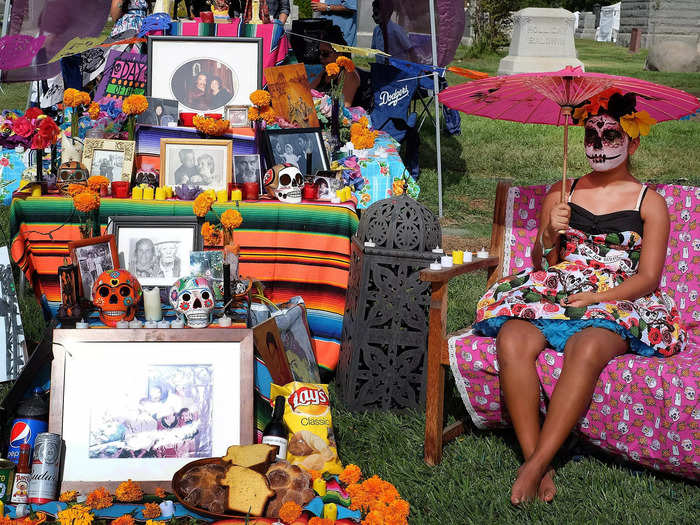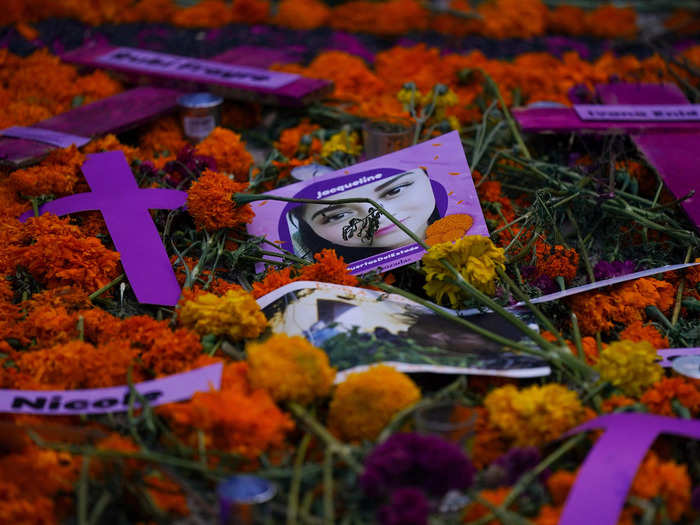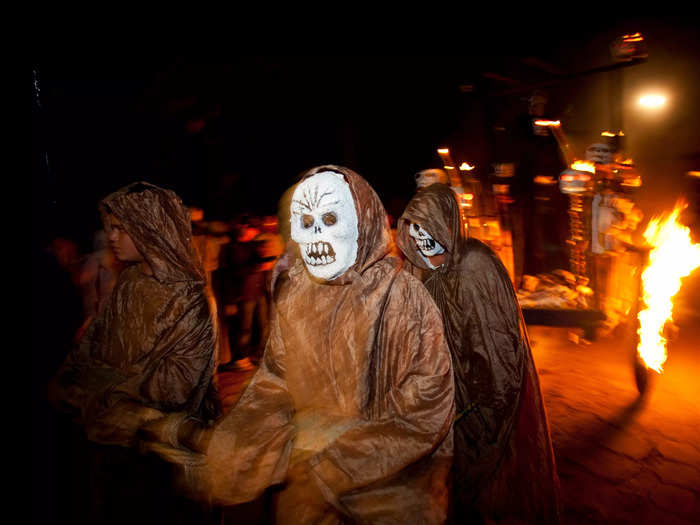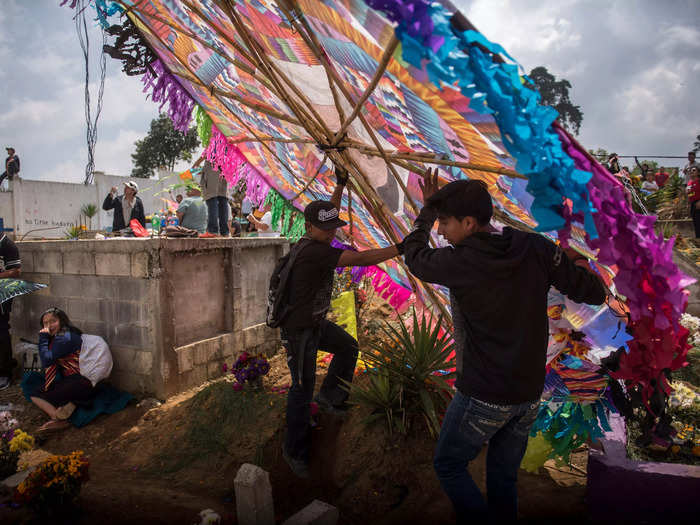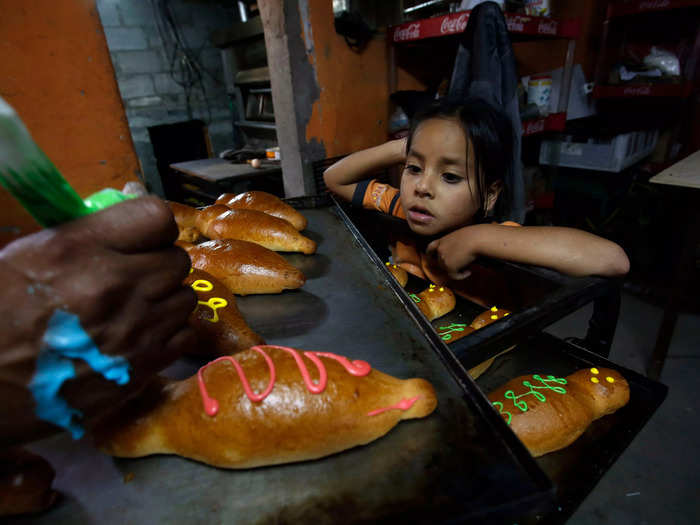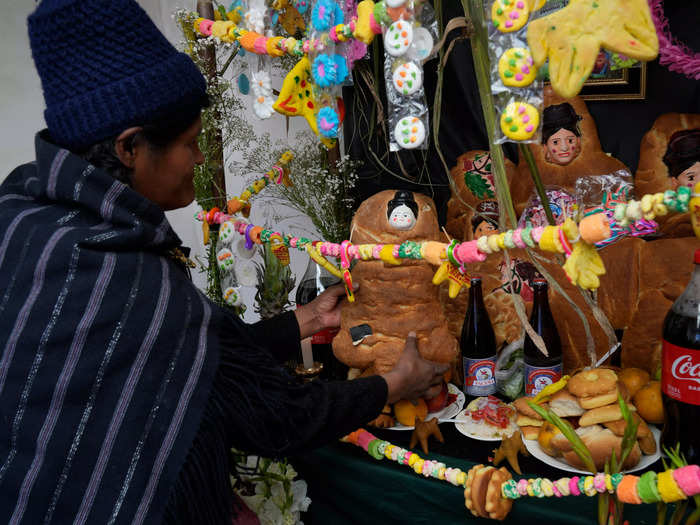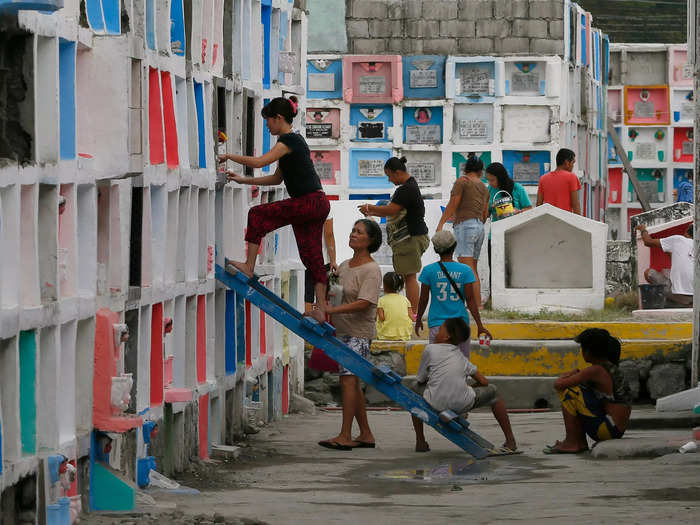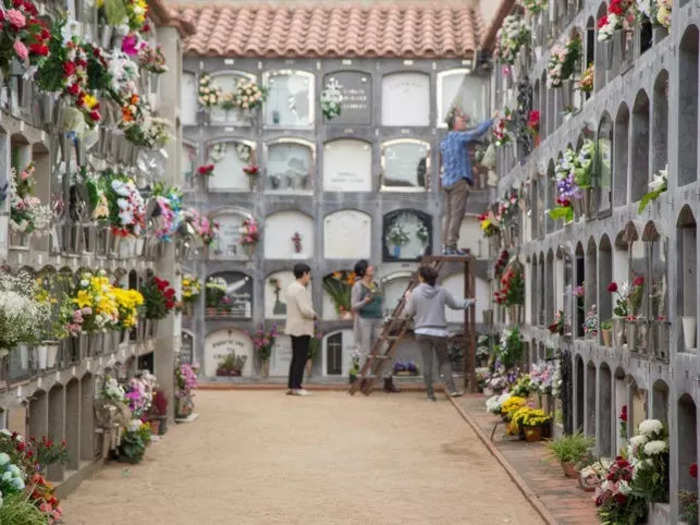Día de los Muertos festivities in Mexico City.Eduardo Verdugo/AP
- Día de los Muertos, also known as All Saints Day, is celebrated every year on November 2.
- Origins of Día de los Muertos celebrations can be traced to a precolonial period in the Americas.
While Día de los Muertos is typically associated with México, it is celebrated across Latin America as well as all around the world. On the first two days of November, people gather to honor the lives of their loved ones through altars, ofrendas, and festivities.
The origin of Día de los Muertos can be traced back to the Mayans and Aztecs who honored the dead, even decades before the Spanish colonized in the 16th century. Eventually, the church converted the holiday into All Saints Day and All Souls Day, to align with the Catholic calendar.
Legend has it that during those first two days of November, the veil which disguises the realm of the dead briefly disappears, granting the living a few brief moments of reunification. Altars are made for the presentation of offerings, or ofrendas, which guide the dearly departed to their loved ones wherever they may be.
From Los Angeles to Manila, these are the special ways in which communities celebrate, mourn, and honor their loved ones.
Hollywood Forever Cemetery Day of the Dead Celebration, Los Angeles
Amanda Hernandaz from the El Sereno section of Los Angeles sits by her family's grave site at the Hollywood Forever Cemetery for the Dia de los Muertos (Day of the Dead) celebration. Richard Vogel/AP Photo
Los Angeles is home to people from all over México and Latin America, and as such, visitors will have the opportuinity to bare witness to a transnational celebration. Every year, the Hollywood Forever Cemetery opens its gates to all Angelenos to join in on the festivities. Extravagant altars, statues, and decorations adorn the tombs that families curate to the likings of their dearly departed friends and family. Folks can enjoy a wide array of delicacies such as pan de muerto, champurrado, and of course, tacos and pupusas. Live entertainment includes, but is not limited to, traditional Aztec and folklorico dances, along with mariachi bands that play all night.
Day of the Dead, México
A photo of woman victim of gender violence is placed on an altar during Day of the Dead celebrations in México City. Fernando Llano/AP Photo
While Día de los Muertos typically consists of altars, parades, and sugar skulls, the current state of violence in México has given this tradition a whole new meaning. As women and girls contiune to dissapear, community members gather around to make altars for victims of femicide. Here, Day of the Dead becomes a time for not only families, but entire countries to mourn the injustices that prevail.
La Calabiuza, El Salvador
People parade in commemoration of the Day of the Dead in Tonacatepeque, outskirts of San Salvador. Edgar Romero/AP
Residents from Tonacatepeque, a municipality in El Salvador, dress up in scary costumes to attend La Calabiuza, a celebration that aims to reclaim Indigenous traditions while rejecting modern Americanized Halloween traditons. During the festivities, people march dressed in skeleton costumes with torches to the local cemetery. Music, dance, and performances are accompanied by ayote en miel, a delicacy made from squash and honey.
Sumpango Giant Kite Festival, Guatemala
Youths try to make their kite fly at the cemetery on All Saints Day in Santiago Sacatepequez, Guatemala. Oliver de Ros/AP Photo
Sumpango is a small town in Guatemala where every year, people gather to bear witness to beautiful kites being flown in the wind in honor of those who have passed on. These colorful kites are a symbol of the union between the world of the living and of the underworld. It can take approximately 40 days to create a hand-painted kite from woven cloth. According to the locals, the kites help guide the spirits on their journeys back to Earth to reunite once again with their loved ones.
Guaguas de Pan, Ecuador
Emily watches her grandfather Francisco Guachamin decorate 'Guaguas de pan' or bread babies in his bakery in Llano Chico, Ecuador. Dolores Ochoa/AP Photo
While we have grown accustomed to the traditional Mexican pan de muerto depicted in mainstream media, Guaguas de pan is a sweet bread served with colada morada during Día de los Muertos festivities in Ecuador. Bread babies are sweet bread shaped into doll-like figures, and decorated with an icing made from powdered sugar. Colada morada, a purple fruit-filled drink made with blue corn flour, is paired with the sweet bread. The recipe and tradition can be traced back to the early 19th century.
Day of the Dead, Bolivia
A relative prepares a table with offerings of food and flowers for his dearly departed during Day of the Dead celebrations in El Alto, Bolivia. Juan Karita/AP Photo
Traditional tantawawas, bread shaped as children, sits on a table as an offering to the dead during Day of the Dead celebrations in El Alto, Bolivia. In comparison to Ecuadorian Guaguas de pan, this delicacy is flavored with either cinnamon or anise. The name is derived from the Quechua language, which is spoken by millions of people in Bolivia. Tantawawas can be small or even life-sized, and every year a competition is held to see who can bake the largest bread child.
Undás, Philippines
Relatives spruce up the crypts of their departed loved ones on the eve of the observance of All Saint's Day among Roman Catholics at suburban Paranaque city south of Manila, Philippines. Bullit Marquez/AP Photo
The Philippines were once a Spanish colony, and as such, Catholic traditions were incorporated into Filipino culture. Undás is celebrated on the first day of November as families gather around in the cemeteries where their loved ones are buried to share a meal, create altars, and pray for their dearly departed.
Todos Los Santos, Spain
Cemetery decorated with flowers for the family of the deceased people on the Day of the Dead, a catholic tradition in Catalonia. Artur Debat/Getty Images
Traditionally, people all throughout Spain purchase flowers to decorate their loved ones' graves while churches hold special masses. In the northern region of the country, friends and families travel to the countryside to partake in a castañada. Chestnuts are roasted in a campfire accompanied by stories and other treats like Buñuelos de viento, a fried dough fritter.

